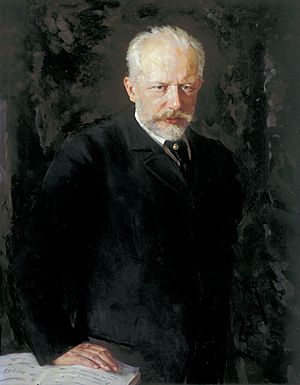Variations on a Rococo Theme facts for kids
The Variations on a Rococo Theme is a famous piece of music. It was written for a cello and an orchestra by Pyotr Ilyich Tchaikovsky. Many people consider it one of the most beautiful pieces for cello and orchestra.
Tchaikovsky never wrote a full cello concerto. Instead, he created this work, which is a main tune followed by several different versions of that tune. These different versions are called variations. The piece is called "Rococo" because its style reminds us of music from the late 18th century. This was the time of composers like Mozart. The main tune in this piece was created by Tchaikovsky himself. It was not an old tune from the 18th century.
Tchaikovsky wrote this music for Wilhelm Fitzenhagen. Fitzenhagen was a German cellist who lived in Russia. Like Tchaikovsky, he taught at the Moscow Conservatory. Fitzenhagen played the piece for the first time in Moscow on 30 November 1877. Nikolai Rubinstein was the conductor.
Contents
The Story of Fitzenhagen's Changes
What happened to the music after its first performance is quite interesting. Tchaikovsky was not there for the first performance. He was in Switzerland trying to recover after a very difficult marriage. He wanted to get the music ready to be published. He sent Fitzenhagen a short version of the music. This was like a piano arrangement. He asked Fitzenhagen to make any needed changes to the cello part. Meanwhile, Tchaikovsky worked on writing out the full orchestra parts. This is called orchestrating the music.
However, Fitzenhagen did more than just change the cello part. He made other big changes too. He left out one of the variations completely. He also changed the order of some of the other variations. When the music was about to be published, Tchaikovsky saw what Fitzenhagen had done. Tchaikovsky was very upset. But he decided to let the publishers print it that way anyway.
When the music was published, it did not say that Fitzenhagen had made so many changes. It took about 70 years for people to realize that Tchaikovsky's original version was different. Some cellists today, like Steven Isserlis, choose to play Tchaikovsky's first version. But most cellists still prefer to play Fitzenhagen's version. It is hard to know which version Tchaikovsky would have liked best. Maybe he let it be printed because he thought Fitzenhagen had made it better. We cannot know for sure. Musicians still discuss which version should be played.
Instruments in the Orchestra
This piece uses a smaller orchestra than Tchaikovsky usually wrote for. It is more like the orchestras used during Mozart's time. There are only two of each woodwind instrument. There are also two horns and the strings section.
How the Music is Structured
The piece lasts about 20 minutes. It starts with a main theme and then has seven variations. Tchaikovsky's original version had eight variations.
- The Main Theme: Moderato semplice
- After a short introduction, we hear the main tune. It is played first by the cello, then by other instruments.
- Variation I: Tempo della Thema
- This first variation is very graceful. You can hear the main tune played with a special rhythm called triplets.
- Variation II: Tempo della Thema
- The second variation sounds like a conversation between the cello and the orchestra. The cello soloist plays a fast scale upwards twice.
- Variation III: Andante sostenuto
- The third variation is very slow and beautiful. It has a calm and peaceful feeling.
- Variation IV: Andante grazioso
- The fourth variation returns to a brighter sound. The tune is elegant and feels like a dance.
- Variation V: Allegro moderato
- In the fifth variation, the flute plays the main tune first. The viola adds some decorative musical ideas. Then the music leads to a cadenza, which is a solo part for the cello.
- Variation VI: Andante
- The sixth variation sounds darker. The cello soloist has a musical conversation with the clarinet.
- Variation VII and Coda: Allegro vivo
- After a short pause, the music becomes fast and lively again. This variation builds up to a big, exciting ending.
Sometimes, other solo instruments play this work. For example, Maxim Rysanov plays it on the viola. He performed it at the Last Night of the Proms in 2010.
See also
 In Spanish: Variaciones sobre un tema rococó para niños
In Spanish: Variaciones sobre un tema rococó para niños


